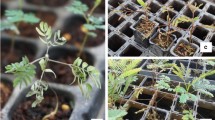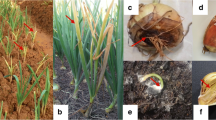Abstract
The effect of temperature on severity of Fusarium wilt of cabbage caused by pathogen Fusarium oxysporum f. sp. conglutinans was assessed. The pathogen was first tested in vitro for growth under different temperatures of 15, 18, 24, 28 and 37 °C. Based on the results, several temperature variants were selected to test the effect of temperature on the infection of plants grown in substrate. Two susceptible and one resistant variety were chosen for the testing. Cabbage plants were cultivated at temperatures of 16/18 °C, 19/21 °C, 22/24 °C and 26/28 °C. Susceptible varieties showed more severe symptoms and greater plant die-off at higher temperatures (22/24 °C and 26/28 °C), compared to lower temperatures (16/18 °C and 19/21 °C). For the resistant variety, the highest incidence of wilt symptoms was observed at 26/28 °C, while the degree of infection was the same as in susceptible plants at lower temperatures. PCR analysis demonstrated that plants grown at lower temperatures with minimum symptoms were also infected with the pathogen. The study suggested losses due to Fusarium wilt could be reduced by cultivating cabbages during colder periods.



Similar content being viewed by others
References
Angadi, S. V., Cutforth, H. W., Miller, P. R., McConkey, B. G., Entz, M. H., Brandt, S. A., & Volkmar, K. M. (2000). Response of three Brassica species to high temperature stress during reproductive growth. Canadian Journal of Plant Science, 80(4), 693–701.
Balasu, A. G., Cristea, S., Zala, C. R., & Oprea, M. (2015). The biological growth parameters of the Fusarium oxysporum f. sp. glycines fungus. Romanian Biotechnological Letters, 20(6), 10 921–10 928.
Cha, S.-D., Jeon, Y.-J., Ahn, G.-R., Han, J. I., Han, K.-H., & Kim, S. H. (2007). Characterization of Fusarium oxysporum isolated from Paprika in Korea. Mycobiology, 35(2), 91–96.
Di Pietro, A., Madrid, M. P., Caracuel, Z., Delgado-Jarana, J., & Roncero, M. I. G. (2003). Fusarium oxysporum: exploring the molecular arsenal of a vascular wilt fungus. Molecular Plant Pathology, 4(5), 315–325.
Dzhalilov, F. S., & Ha, V. T. N. (2014). Cabbage diseases control in field. Potato and Vegetables, 54, 20–23.
Epstein, L., Kaur, S., Chang, P. L., Carrasquilla-Garcia, N., Lyu, G., Cook, D. R., Subbarao, K. V., & O’Donnell, K. (2017). Races of the celery pathogen Fusarium oxysporum f. sp. apii are polyphyletic. Phytopathology, 107, 463–473.
Farooq, S., Iqbal, S. M., & Rauf, C. A. (2005). Physiological studies of Fusarium oxysporum f. sp. ciceri. International Journal of Agriculture & Biology, 7(2), 275–277.
Fayzalla, E. A., Shabana, Y. M., & Mahmoud, N. S. (2008). Effect of environmental conditions on wilting and root rot fungi pathogenic to solanaceous plants. Plant Pathology Journal, 7(1), 27–33.
Flood, J. (2006). A review of Fusarium wilt of oil palm caused by Fusarium oxysporum f. sp. elaeidis. Phytopathology, 96, 660–662.
Fovo, J. D., Dostaler, D., & Bernier, L. (2017). Influence of culture media and temperature on growth and sporulation of Lasiodiplodia theobromae, Pestalotiopsis microspora and Fusarium oxysporum isolated from Ricinodendron heudelotii in Cameroon. International Journal of Current Microbiology and Applied Sciences, 6(6), 3098–3112.
Fravel, D. R., Stosz, S. K., & Larkin, R. P. (1996). Effect of temperature, soil type, and matric potential on proliferation and survival of Fusarium oxysporum f. sp. erythroxyli from Erythroxylum coca. Phytopathology, 86, 236–240.
Gaetán, S. A. (2005). Occurrence of Fusarium wilt on canola caused by Fusarium oxysporum f. sp. conglutinans in Argentina. Plant Disease, 89, 432.
Garibaldi, A., Gilardi, G., & Gullino, M. L. (2006). Evidence for an expanded host range of Fusarium oxysporum f. sp. raphani. Phytoparasitica, 34(2), 115–121.
Gupta, V. K., Misra, A. K., & Gaur, R. K. (2010). Growth characteristics of Fusarium spp. causing wilt disease in Psidium guajava L. in India. Journal of Plant Protection Research, 50(4), 452–462.
Hibar, K., Daami-Remadi, M., Jabnoun-Khiareddine, H., & El Mahjoub, M. (2006). Temperature effect on mycelial growth and on disease incidence of Fusarium oxysporum f.sp. radicis-lycopersici. Plant Pathology Journal, 5(2), 233–238.
Jiménez-Díaz, R. M., Castillo, P., Jiménez-Gasco, M. M., Landa, B. B., & Navas-Cortés, J. A. (2015). Fusarium wilt of chickpeas: Biology, ecology and management. Crop Protection, 73, 16–27.
Kendrick, J. B. (1930). Kale yellows in California, caused by Fusarium conglutinans Wollenw. Hilgardia, 5(1), 1–15.
Kochman, J. (2007). Fusarium oxysporum f. sp. Conglutinans. Fusarium wilt of canola. Plant Health Australia. http://www.planthealthaustralia.com.au/pests/fusarium-wilt-of-canola/. Accessed 5 December 2018.
Koike, S. T., Gladders, P., & Paulus, A. O. (2007). Vegetables diseases. London: Manson Publishing Ltd..
Landa, B. B., Navas-Cortés, J. A., Hervás, A., & Jiménez-Díaz, R. M. (2001). Influence of temperature and inoculum density of Fusarium oxysporum f. sp. ciceris on suppression of Fusarium wilt of chickpea by rhizosphere bacteria. Phytopathology, 91(8), 807–816.
Landa, B. B., Navas-Cortés, J. A., Jiménez-Gasco, M. M., Katan, J., Retig, B., & Jiménez-Diáz, R. M. (2006). Temperature response of chickpea cultivars to races of Fusarium oxysporum f. sp. ciceris, causal agent of Fusarium wilt. Plant Disease, 90, 365–374.
Lange, R. M., Gossmann, M., & Büttner, C. (2007). Yield loss in susceptible cultivars of spring rapeseed due to Fusarium wilt caused by Fusarium oxysporum. Communications in Agricultural and Applied Biological Sciences, 72(4), 723–734.
Larkin, R. P., & Fravel, D. R. (2002). Effects of varying environmental conditions on biological control of Fusarium wilt of tomato by nonpathogenic Fusarium spp. Phytopathology, 92, 1160–1166.
Liu, X., Ling, J., Xiao, Z., Xie, B., Fang, Z., Yang, L., Zhang, Y., Lv, H., & Yang, Y. (2017). Characterization of emerging populations of Fusarium oxysporum f. sp. conglutinans causing cabbage wilt in China. Journal of Phytopathology, 165(11–12), 813–821.
Luhová, L., Lebeda, A., Kutrová, E., Hedererová, D., & Peč, P. (2006). Peroxidase, catalase, amine oxidase and acid phosphatase activities in Pisum sativum during infection with Fusarium oxysporum and F. solani. Biologia Plantarum, 50(4), 675–682.
Mogensen, J. M., Nielsen, K. F., Samson, R. A., Frisvad, J. C., & Thrane, U. (2009). Effect of temperature and water activity on the production of fumonisins by Aspergillus niger and different Fusarium species. BMC Microbiology, 9, 281.
Mohsen, L. Y., Al-Janabi, J. K. A., & Jebor, M. A. (2016). The effect of some environmental conditions on the growth and activity of the external enzymes for five sp. of Fusarium. Journal of Babylon University. Pure and Applied Sciences, 24, 630–646.
Morrison, M. J., McVetty, P. B. E., & Shaykewich, C. F. (1989). The determination and verification of a baseline temperature for the growth of Westar summer rape. Canadian Journal of Plant Science, 69(2), 455–464.
Navas-Cortés, J. A., Landa, B. B., Méndez-Rodríguez, M. A., & Jiménez-Díaz, R. M. (2007). Quantitative modeling of the effects of temperature and inoculum density of Fusarium oxysporum f. sp. ciceris races 0 and 5 on development of Fusarium wilt in chickpea cultivars. Phytopathology, 97, 564–573.
Ramamoorthy, V., Raguchander, T., & Samiyappan, R. (2002). Induction of defense-related proteins in tomato roots treated with Pseudomonas fluorescens Pf1 and Fusarium oxysporum f. sp. lycopersici. Plant and Soil, 239(1), 55–68.
Rosa, E. A. S., & Rodrigues, P. M. F. (1998). The effect of light and temperature on glucosinolate concentration in the leaves and roots of cabbage seedlings. Journal of the Science of Food and Agriculture, 78(2), 208–212.
Scott, J. C., Gordon, T. R., Shaw, D. V., & Koike, S. T. (2010). Effect of temperature on severity of Fusarium wilt of lettuce caused by Fusarium oxysporum f. sp. lactucae. Plant Disease, 94, 13–17.
Shabani, F., Kumar, L., & Esmaeili, A. (2014). Future distributions of Fusarium oxysporum f. spp. in European, Middle Eastern and North African agricultural regions under climate change. Agriculture, Ecosystems & Environment, 197, 96–105.
Somu, R., & Thammaiah, N. (2015). Physiological studies of Fusarium oxysporum f. sp. cubense causing panama wilt in banana. The Bioscan, 10(4), 1721–1724.
Webb, K. M., Brenner, T., & Jacobsen, B. J. (2015). Temperature effects on the interactions of sugar beet with Fusarium yellows caused by Fusarium oxysporum f. sp. betae. Canadian Journal of Plant Pathology, 37(3), 353–362.
Wszelaki, A., & Kleinhenz, M. D. (2003). Yield and relationships among head traits in cabbage as influenced by planting date and cultivar. II. Processing. HortScience, 38(7), 1355–1359.
Yaniv, Z., Schafferman, D., & Zur, M. (1995). The effect of temperature on oil quality and yield parameters of high- and low-erucic acid Cruciferae seeds (rape and mustard). Industrial Crops and Products, 3(4), 247–251.
Zhang, J., Ling, J., Xie, B., & Yang, Y. (2014). Rapid detection and identification of Fusarium oxysporum f. sp. conglutinans race 1 and race 2. Acta Phytopathologica Sinica, 44(6), 586–594.
Acknowledgements
This work was supported by the Ministry of Agriculture of the Czech Republic within the project NAZV QJ1510088.
Author information
Authors and Affiliations
Corresponding author
Ethics declarations
This study did not involve any human participants and/or animals.
Conflict of interest
The authors declare that they have no conflict of interest.
Rights and permissions
About this article
Cite this article
Jelínek, T., Koudela, M., Kofránková, V. et al. Effect of temperature on severity of Fusarium wilt of cabbage caused by Fusarium oxysporum f. sp. conglutinans. Eur J Plant Pathol 155, 1277–1286 (2019). https://doi.org/10.1007/s10658-019-01855-3
Accepted:
Published:
Issue Date:
DOI: https://doi.org/10.1007/s10658-019-01855-3




